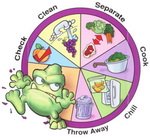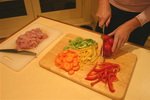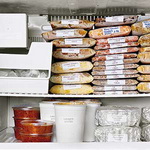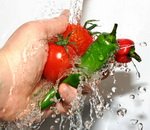|
Food Cross Contamination – Avoiding The Spread of BacteriaFood cross contamination occurs easily when foods that are cooked pick up bacteria from other foods, unwashed hands, cutting boards and kitchen utensils during the preparation process. It is important to keep raw meat, poultry, fish and shellfish and eggs away from other foods.
Food cross contamination can be avoided by: • Not using the same cutting board that raw meat, poultry, fish and seafood was chopped on to prepare other foods such as vegetables, and washing these cutting boards and hands immediately after use with warm soapy water. • Never put cooked food on a plate that was used for raw meat, poultry, fish or seafood without first washing the plate in warm soapy water thoroughly.
• Raw meat, poultry, fish and seafood should be kept separate in the grocery cart from other foods.
• Foods should be repackaged when they are brought home from the grocery store in clean food storage bags and the original packaging discarded.
• The sink and any sink mats that have come in contact with raw meat, poultry, fish, seafood and raw vegetables should be washed thoroughly with warm soapy water. • Wash fruits and vegetables thoroughly to remove dirt and grime. • When food are added to marinate foods such as meats, poultry, fish, and seafood, marinating should take place in the refrigerator, and the marinade should only be used on the cooked food if it is also cooked, raw marinade should never be used.
For some great sections on food cross-contamination some great references are: • The Taste of Home Cookbook – All New Edition from Taste of Home Books, Reiman Media Group • The All New Good Housekeeping Cook Book, Edited by Susan Westmoreland, Hearst Books, New York • Betty Crocker Cookbook – New Edition, by Wiley Publishing, Inc.
Cooking Basics
|
To Prevent Cross-Contamination Resulting In Food Borne Illnes Such As Salmonella:

Avoid Using The Same Cutting Board For Meats and Produce

Repackage Foods Brought Home From The Grocery Store Before Refrigerating

Wash Fruit and Produce Thoroughly To Remove Dirt And Grime






